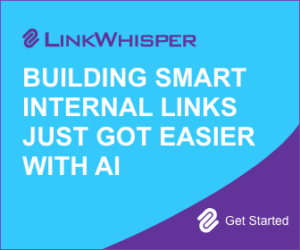13 Of The Best Ad Networks for Bloggers To Enjoy Passive Income
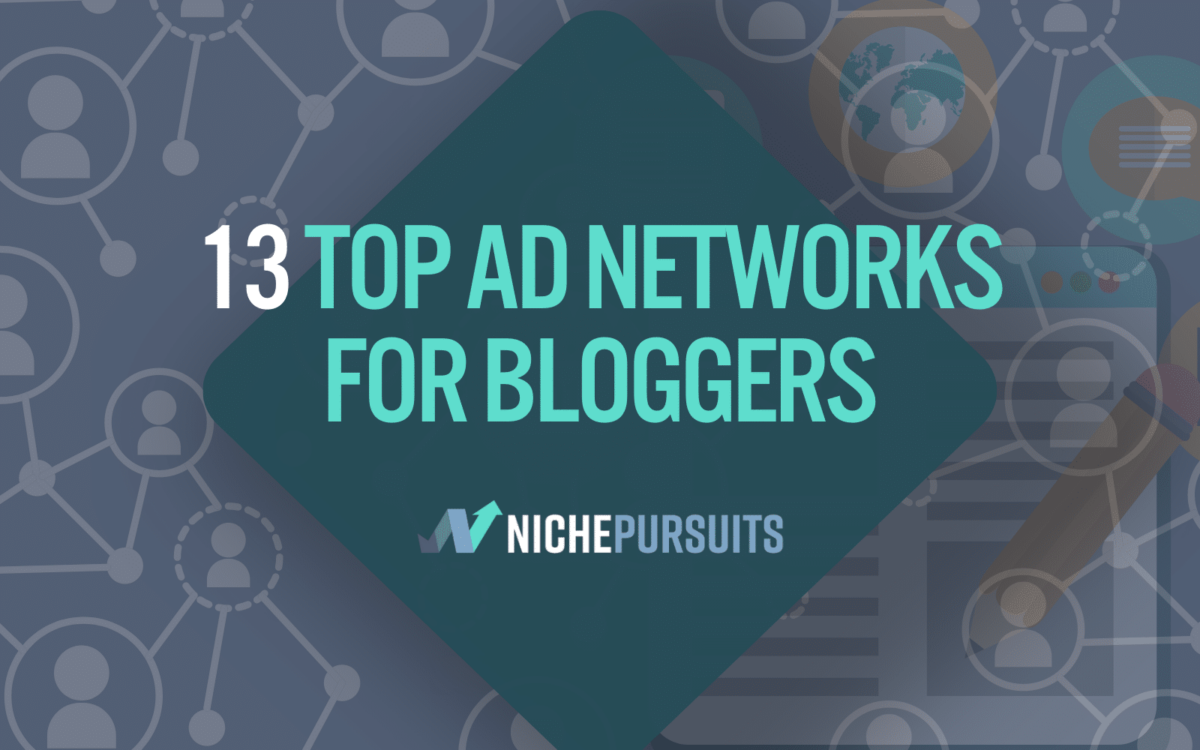
When you buy something through one of the links on our site, we may earn an affiliate commission.
Which are some of the best ad networks for bloggers?
There are thousands of ad networks with varying approval procedures, payment models, and traffic requirements. They all work slightly differently, so it's good to compare and contrast them with one another.
To make it easier for you, I will discuss some of the best blogging ad networks to make money, how they work, and how to choose one.
In a hurry?
Ezoic is an easy choice for all bloggers looking to profit from ads. It's easy to set up, has no traffic requirement, and is built for sites of all shapes and sizes.
Get Started With Ezoic TodayContents
How Do Ad Networks Work?
An ad network is an intermediary between a publisher (you) and the advertiser.
The goal of a blogger is to offer value to their audience, and once the audience grows, they can monetize it by displaying ads. On the other hand, advertisers pay ad networks a lot of money to present their business to a bigger audience.
And since the ad networks don’t own any blogs, they will rely on bloggers for traffic. Most ad networks pay bloggers for their ad space through a revenue-sharing system. These are known as Performance ad networks or affiliate ad networks.
That’s why you’ll come across abbreviations such as CPC, CPM, RPM, etc. (more on this in a minute).
Other types of ad networks include:
- Vertical ad networks – These are specialized in specific niches, such as fashion, women, automotive, etc.
- Premium ad networks – These often offer content suggestion ads from top-notch publishers such as FOX News or BBC
- Inventory-Specific Ad Networks – As the name suggests, they specialize in one inventory – that could be Native Ads, Mobile Ads, or Video ads networks
Best Ad Networks for Bloggers
The best ad network for you will be different from the best ad network for the next blogger, so dig deep and pinpoint the features best suited to your niche.
1. Ezoic
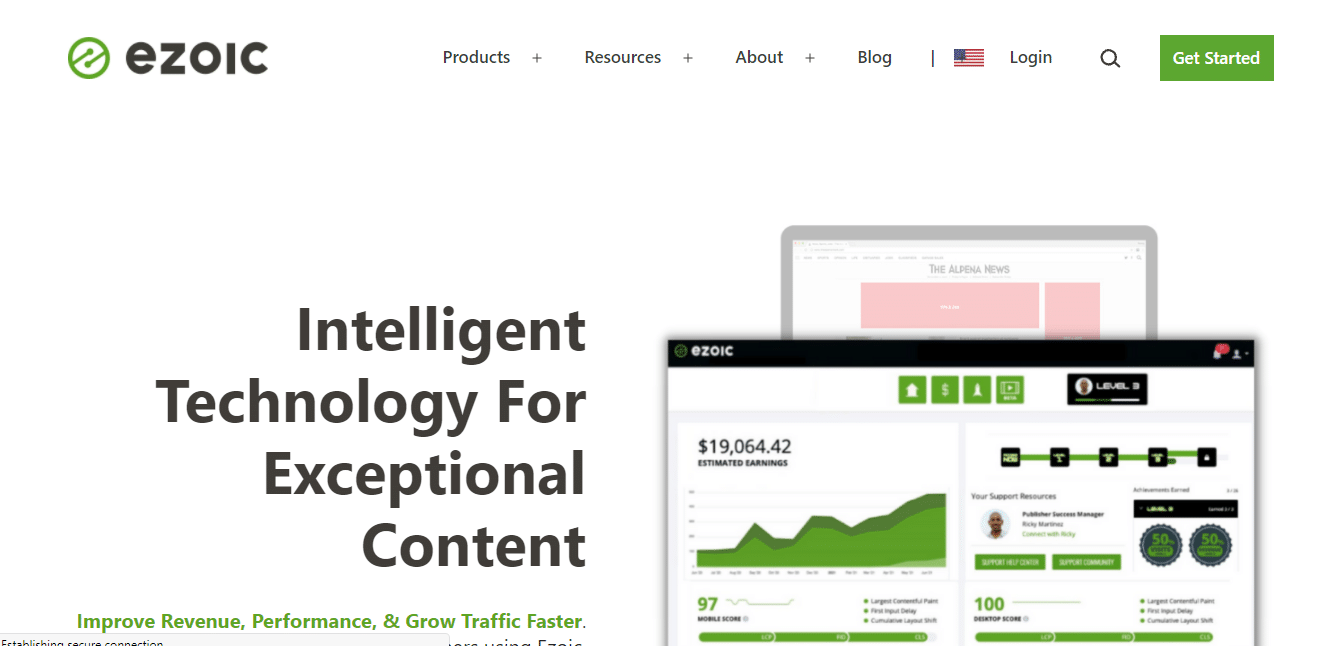
Ezoic is one of the best ad networks you can join. It allows users to set where they want to place the ads by selecting placeholders. Then, they utilize AI to determine the best ways to serve ads to your audience.
If you’re already working with other ad networks, such as Google AdSense or Media.net, you can still earn with Ezoic in a system called Mediation.
Being a Google Certified Publishing Partner, Ezoic follows the best practices in placing and serving ads to your audience.
Ezoic provides a better alternative to major ad networks such as Mediavine and Adthrive than need at least 50,000 visitors with them. Initially, you needed at least 10,000 visitors per month to join Ezoic.
But they’ve eased their requirements. Now, all you need is high-quality content, and you can start earning with little traffic. Their EPMVs are also quite good, allowing you to still earn an income as your site grows.
However, EPMVs are only high for US-based traffic. So, if you get blog traffic from other parts of the world, you’ll need lots of traffic to break even with Ezoic. Learn more in our full Ezoic review!
Pros:
- It’s easy to join and use
- They are a Google Certified Publishing Partner
- They have an affiliate program where you earn 3% of the earnings your referrals make
- They’ve partnered with a wide range of advertisers around the globe, allowing the serve ads appropriate to each region
Cons:
- You need traffic from the US to earn a sustainable income
- There are cases where integration with Ezoic affects the website's core web vitals
Minimum Payout – $20
Traffic Requirements – None
Payment Model – CPM
2. Google AdSense
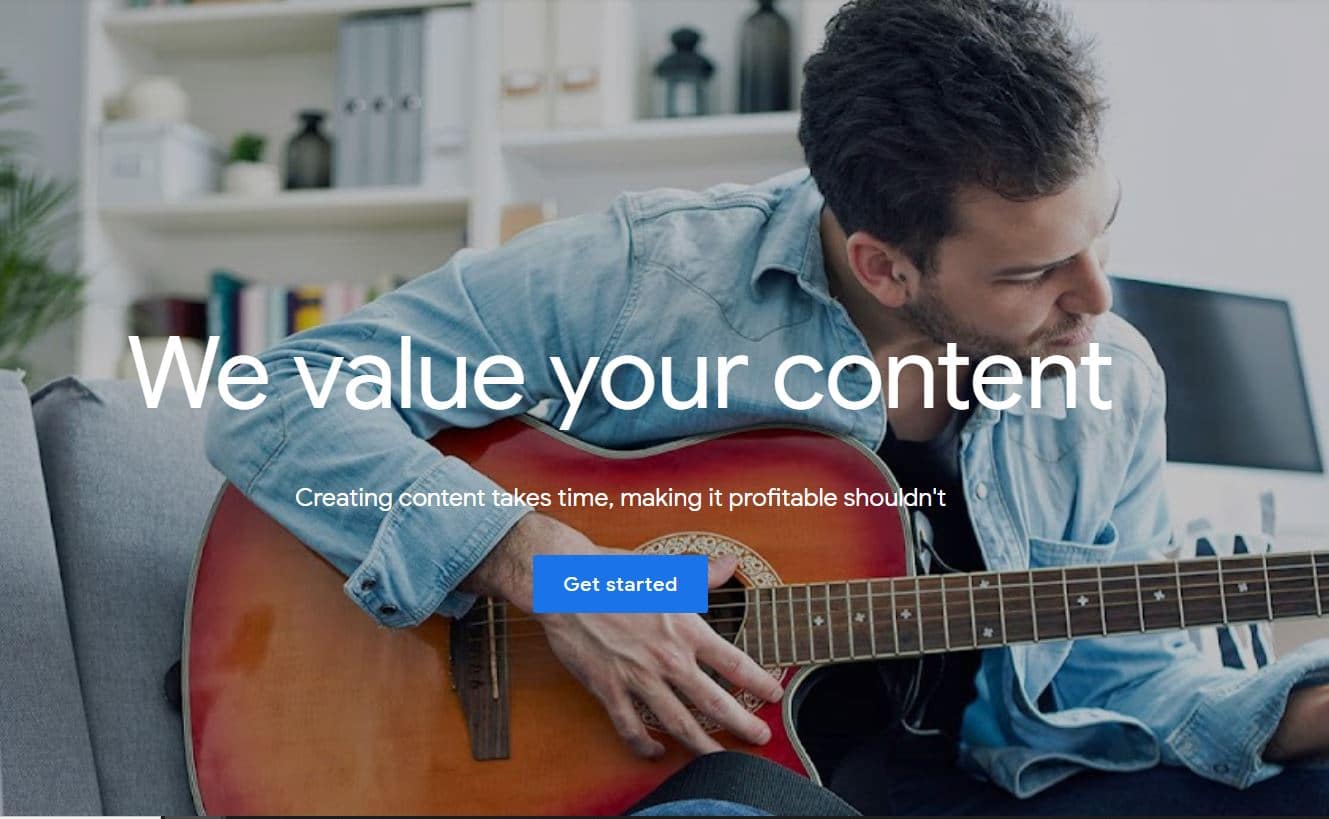
Google AdSense is probably the most recognizable ad network. When I first started blogging, my goal was to earn through AdSense.
Google AdSense is a network owned by Google that allows bloggers to place ads on their websites and earn per click. Google AdSense also uses a revenue-sharing system where the publisher gets 68%, and AdSense keeps the rest.
Applying for AdSense isn’t that complicated. Once you sign up, you get a code that you will add to your website and wait for them to review your website. There's no guarantee that they will approve your site.
But once they do, you can select Auto Ads, where ads are automatically distributed on your website (learn more on how to get ads on your website here). And when you don’t want the ads to show up on certain pages, you can switch them off for those pages.
The only downside with using AdSense you need a lot of traffic to earn a considerable income. So, when you get a lot of traffic, you might want to check with more lucrative ad networks like Ezoic or Mediavine (more on this one later).
Pros:
- It’s free to join
- A wide range of customization options
- The Auto Ads make it very easy to set up
- There’s no minimum traffic requirement
Cons:
- The payment threshold is £70 ($100)
Minimum Payout – £70 ($100)
Traffic Requirements – None
Payment Model – CPC
3. Mediavine
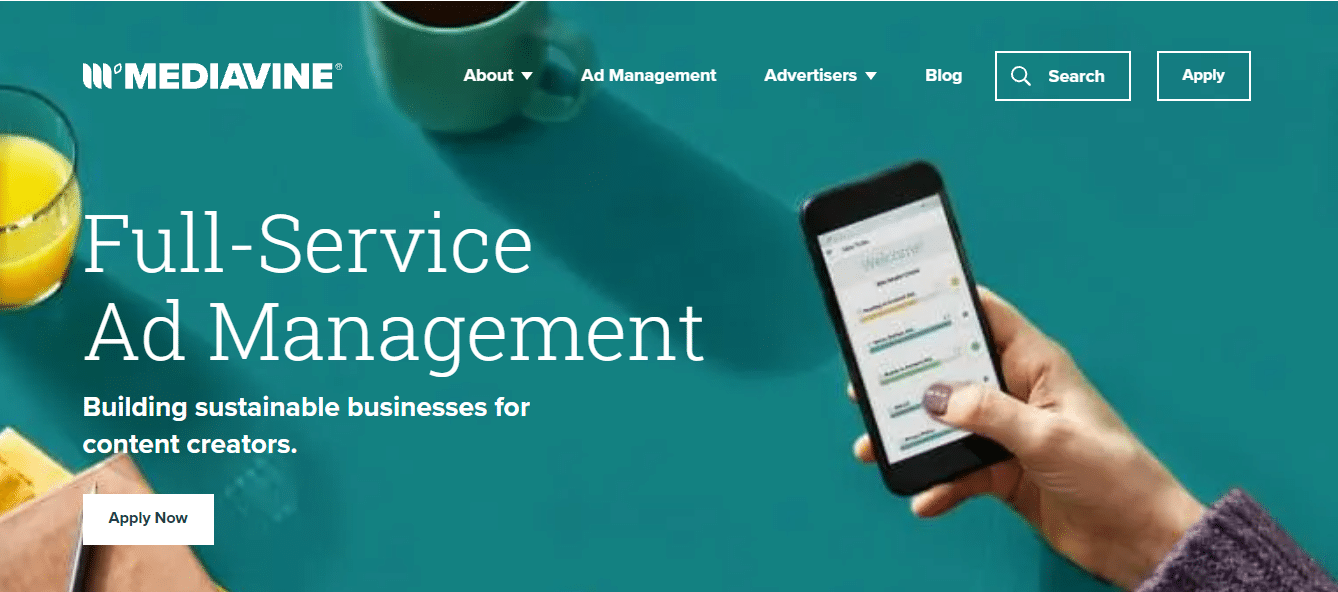
Mediavine is considered by many to be the best ad network.
To profit from it though, you must first meet their minimum traffic requirements of at least 50,000 impressions per month, mostly from traffic from USA (see Ezoic vs Mediavine). But if you can reach that, you enjoy some of the highest RPMs, an easy-to-use interface, and a guarantee that you will be working with some of the top advertisers.
It's a very popular ad network as most people have reported an increase in income when they shifted from ad networks like Ezoic or AdSense. But that is not always the case since niches and sources of traffic have varying metrics.
But the good thing is that you can test all of them and choose the one that works for you.
While you can't predict the RPMs, Mediavine uses a revenue-sharing system, where the publisher gets at least 75%. This is one of the highest a publisher can get compared to most of the ad networks you'll come across.
Pros:
- Increased earnings
- High-quality ads and a better user experience for your audience
- Transparency in reporting and analytics, allowing you to make data-driven decisions
- It pays per impression, which is a better model compared to pay per click
Cons:
- The 50,000 per month impressions requirement is quite challenging to achieve
Minimum Payout – $25 to $200
Traffic Requirements – 50,000 impressions per month
Payment Model – CPM
4. Amazon Associates
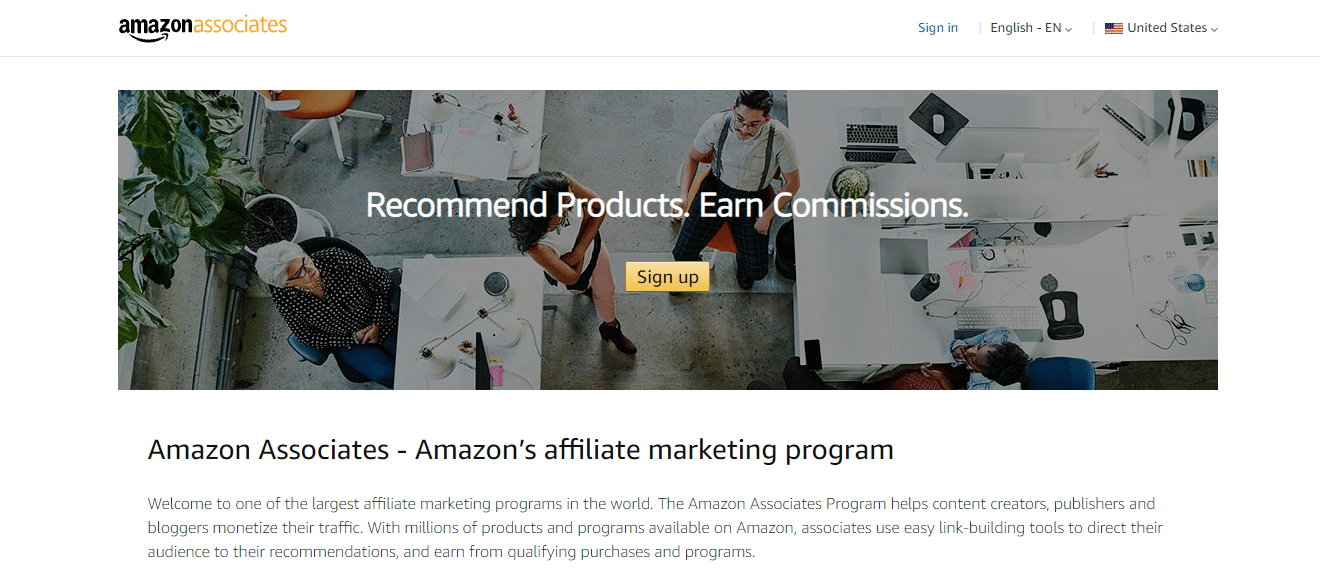
Amazon Associates is one of the most popular affiliate programs where you earn a commission when people buy through the links you've placed in your articles. But to increase your earning potential, you can sign up for their ad network.
Unlike in AdSense or Ezoic, where you are either paid by impressions or clicks, for Amazon Associates, the buyer has to buy a product.
Even when they don't buy the product recommended on the ad but buy a different product, you still get a commission as long as they use your link.
While you may not always earn as much as you would with other ad networks, it's an excellent way to get the most out of your affiliate site.
Pros:
- It’s easy to join. All you need to do is sign up and make at least 3 sales within 180 days
- They have a low payment threshold ($10)
- You earn a commission regardless of the product the buyer buys
Cons:
- You only earn a commission when the buyer checks out
Minimum Payout – $10
Traffic Requirements – None
Payment Model – CPA
5. AdThrive
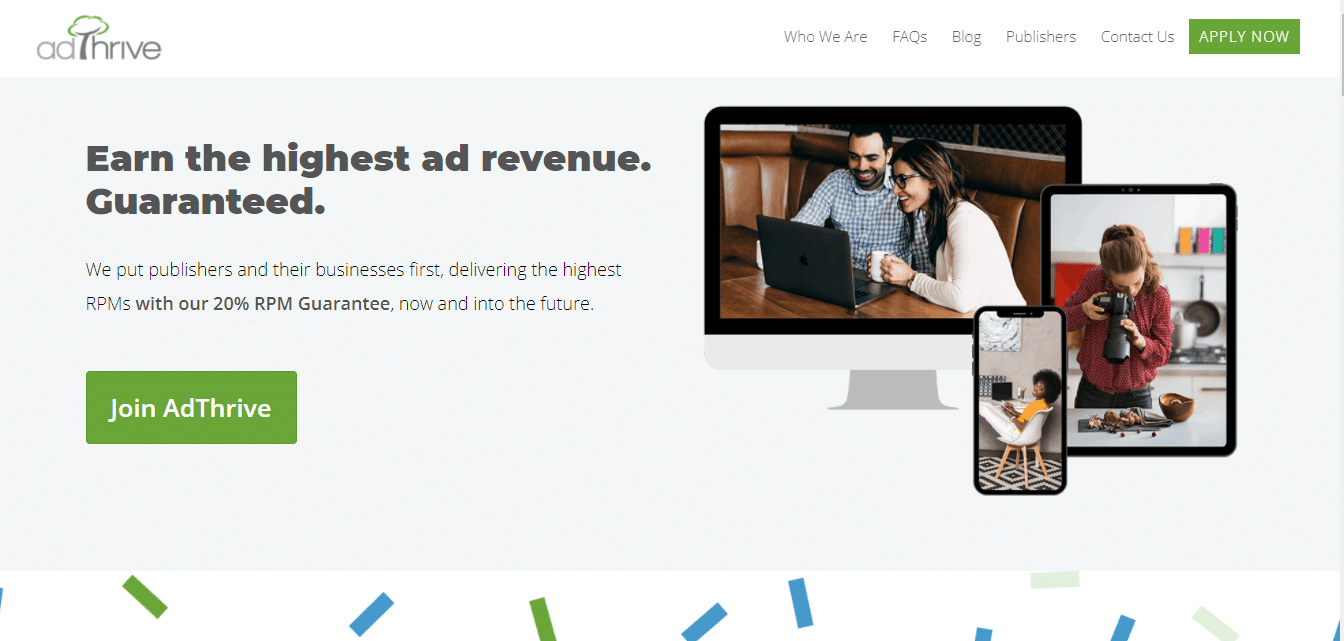
AdThrive is certainly one of the best ad networks that most publishers want to join (see our post, Ezoic Vs Adthrive).
If you thought Mediavine's minimum traffic requirements were hard to achieve, wait until you try getting into AdThrive where you need at least 100,000 pageviews. But once you cross that mark and your website meets their criteria, you can relax as you watch the dollars trickle into your account.
Websites in the travel, food, parenting, and DIY niches tend to do well with AdThrive, but websites in other niches are acceptable too. Also, you only get to enjoy high payouts if your traffic is mainly from the US.
One of the reasons AdThrive is arguably the best ad network for site owners is they are publisher-oriented. You are assured of getting paid even when advertisers don’t pay them.
Once you are approved, their very supportive staff will guide you through the setup process, and you even have an option to buy some of their courses and learn to get the most out of this network.
Pros:
- Very high earning potential
- Very helpful support staff
- High-Quality ads that follow Google’s publishing policies
Cons:
- The traffic requirement is relatively high
Minimum Payout – $25 to $100
Traffic Requirements – 100,000 page views per month
Payment Model – CPC
6. PropellerAds
All the ad networks I've reviewed so far are great, but they only offer display ads.
If you're looking for more ways to serve ads to your audience. Moreover, the more ways you can serve ads, the more impressions and clicks you'll have on your ads. That translates to more earnings for you and the advertiser.
Better yet, they can pay either through CPC, CPM, CPL, and CPI.
PropellerAds allows you to show ads in the following ways:
- PopUnder
- Native Ads
- Push Notifications
- Interstitial
However, PropellerAds aren't very restrictive with advertisers. As a result, you may not always get high-quality ads. But it's still a good AdSense alternative for a small publisher.
Pros:
- It’s easy to join and use
- Low payment threshold
Cons:
- Arguably lower quality ads
Minimum Payout – $5
Traffic Requirements – None
Payment Model – CPM, CPC, CPA, CPI, CPL
7. Infolinks

Infolinks is another great AdSense alternative for small blogs.
It is best known for contextual ads that ensure your website shows ads without appearing spammy.
But over the years, they have introduced other ad formats such as:
- InFold
- InTag
- InFrame
- InArticle
- InScreen
However, it doesn't have a good ROI compared to AdSense or Ezoic. But when you can’t get approval for those, it might still be a good option.
Better yet, it's straightforward to set up, and their approval process takes anywhere between a few minutes and a few days. You can also use it to increase your AdSense income since you can use Infolinks and AdSense ads on the same website without any conflicts.
Pros:
- It's beginner-friendly
- Different ad platforms to choose from
- Their ads are responsive on all devices
- You can use it alongside AdSense
Cons:
- Low earning potential
- Ads can get messy, affecting your user experience
Minimum Payout – $50
Traffic Requirements – None
Payment Model – CPC
8. Sovrn
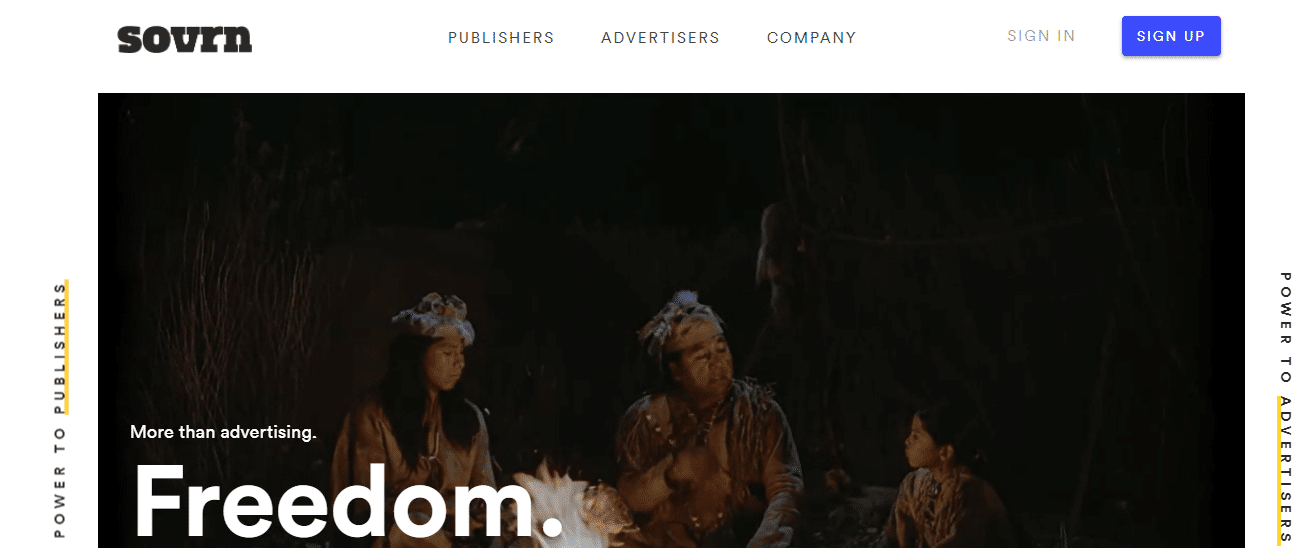
Launched in 2014, Sovrn is one of the largest ad networks, offering publishers various tools to monetize their websites. It's often featured in round-ups of the best ad networks for bloggers.
These include:
- Waterfall advertising and header bidding, assuring publishers some of the highest CPMS
- Data monetization where bloggers can also monetize their email campaigns
- Signal – a feature that allows you to study your audience and customize your ad units based on the audience’s behavior on the site
- Affiliate Marketing and eCommerce – Sovrn acquired Viglinks in 2018, allowing publishers to convert all the links in their content into affiliate links
- Server-to-server bidding, which improves user experience on your website
- The ability to detect Adblockers on browsers and ask users to allow ads on their devices
What you’ll love most is their easy-to-use Meridian Platform that allows you to manage every aspect from one dashboard.
Pros:
- Various ad formats to choose from
- You can customize your ad units based on your audience
- You get an account manager
Cons:
- Low earning potential for non-US traffic
- Their approval process is quite strict
Minimum Payout – $50
Traffic Requirements – None
Payment Model – CPM
9. Monumetric
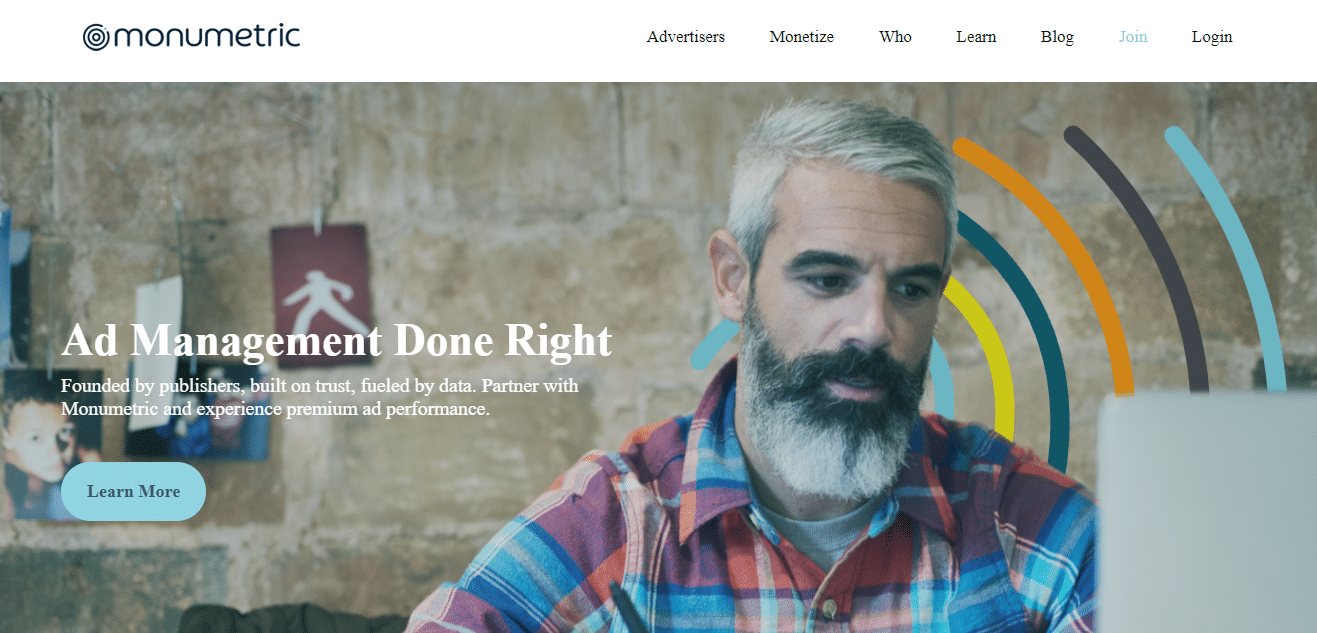
Formerly known as The Blogger Network, Monumetric offers one of the best ways for publishers to monetize their blogs with advertising space.
Unlike networks like AdSense, where they display static ads, Monumetric is dynamic.
They will serve banner ads, videos, in-text ads, and any other types of ad units based on how the user surfs the web. You may have noted that some networks will only serve one ad per session. But with some other ad network like Monumetric, they’ll keep serving different relevant ad units, leading to higher CTRs.
However, you need at least 10,000 page views per month and a $99 one-time setup fee. This may sound steep, but it's better than AdSense and Ezoic and the closest you can get to Mediavine if you don't have the 50,000 sessions per month yet.
Besides, if you have traffic of more than 80,000 per month, you don't need to pay anything.
Pros:
- High earning potential
- It’s a dynamic network that customizes ad units based on the audience
- They handle the ad setup for you
- Wide variety of ads
Cons:
- There’s a one-time setup fee
- Monumetric only supports WordPress and Blogger websites
Minimum Payout – $10
Traffic Requirements – 10,000 page views per month
Payment Model – CPM
10. RevenueHits
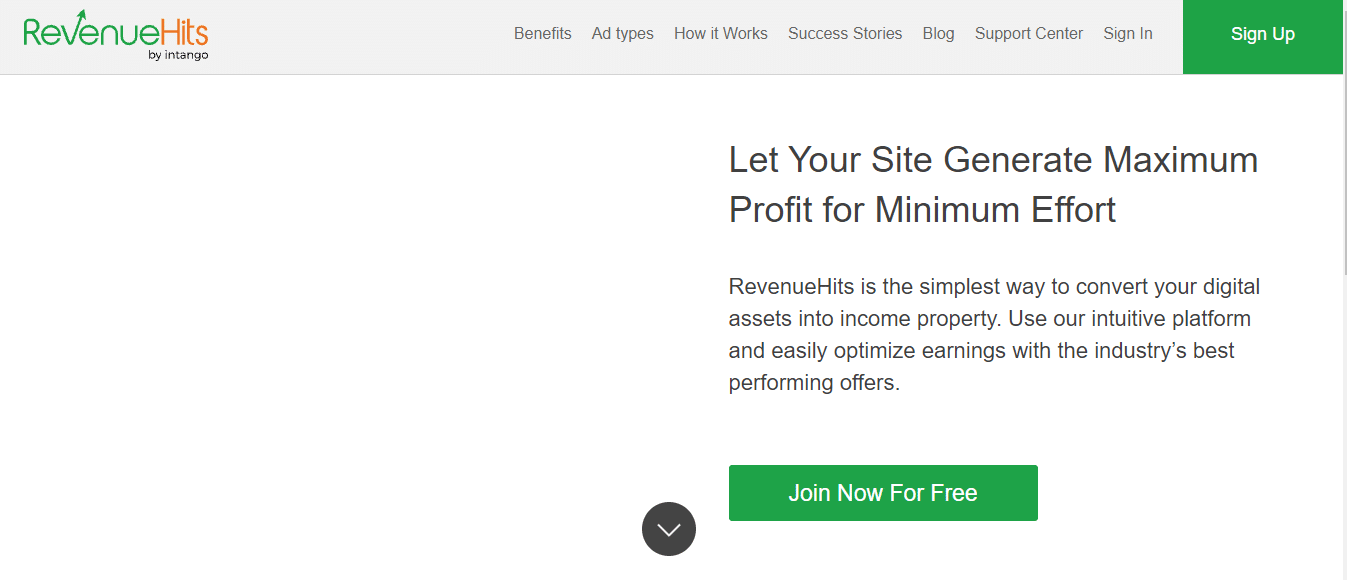
RevenueHits is a unique ad network in that it uses a CPA (Cost Per Acquisition) model whereby, instead of being paid for clicks, you are paid for every action or conversion.
This makes it one of the best ad networks for bloggers with low traffic since you don’t need lots of traffic to earn a lot of money. However, while you could make a lot of money with a CPA model, clicks and Impressions are still the easiest ways to earn from traffic.
RevenueHits also offers a wide range of ads, including contextual ads, Pop-Unders, banners, Footer Sticky, Shadow Boxes, and the ability to detect AdBlocks.
While they may not be a large network like AdSense, RevenueHits has partnered with several advertisers. They have a considerable ad inventory, and you can rest assured they will serve relevant ads based on the users’ demographic.
Pros:
- A vast ad inventory and ad formats
- It’s free and easy to join
- The CPA model increases your earning potential
- You have more control over the ads you want to show
Cons:
- You will not earn from clicks or impressions
Minimum Payout – $20 to $500
Traffic Requirements – None
Payment Model – CPA, CPM
11. Media.net
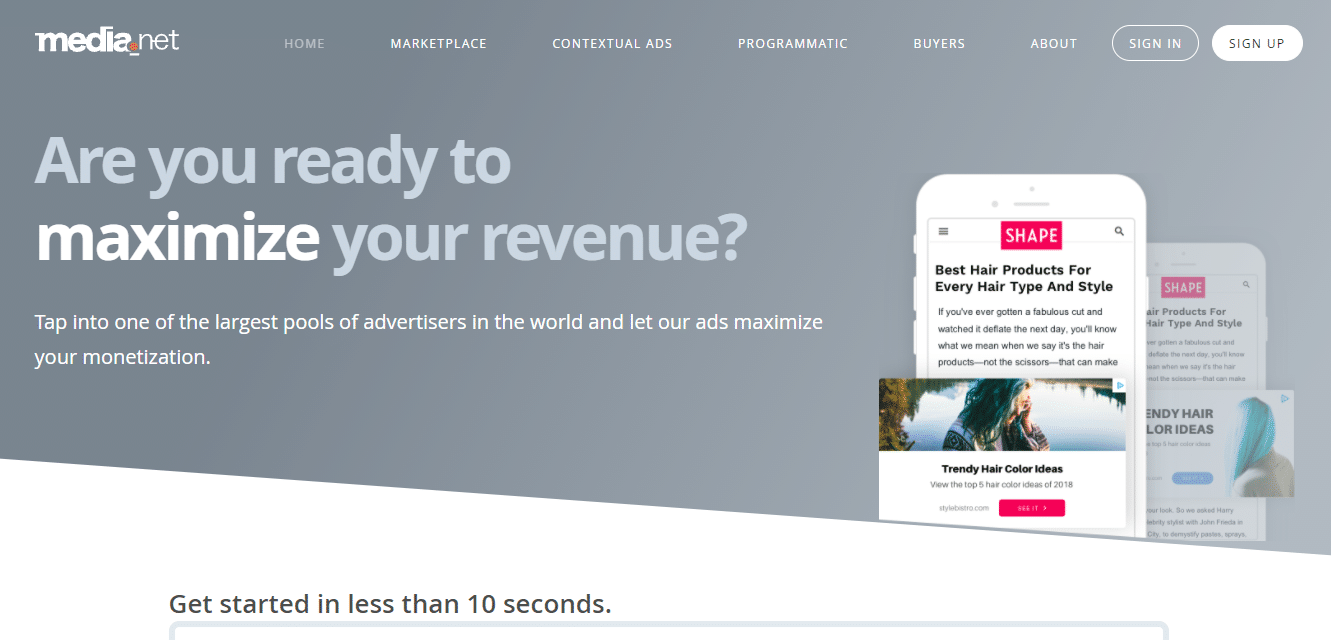
Media.net is a suitable ad network for those who prefer contextual ads.
Unlike other networks that will serve ads based on what the audience likes, these kinds of ads are typically related to the content on your website.
For instance, if you have a blog about laptops, the ads shown will be about laptops. This makes the ads look more natural, increasing the click-through rates.
Better yet, Media.net is powered by Yahoo and Bing, which are excellent alternative sources of traffic used by a wide range of advertisers. Like AdSense, there's no traffic requirement, it's a great ad network for bloggers, and joining is as easy as joining Infolinks.
Pros:
- It offers some of the best RPMs for contextual ads
- It’s free and easy to use
- Excellent customer support
- Large ad inventory
Cons:
- Low earning potential if your traffic is from the US, UK, or Canada
Minimum Payout – $100
Traffic Requirements – None
Payment Model – CPA, CPM, CPL, CPC
12. Taboola
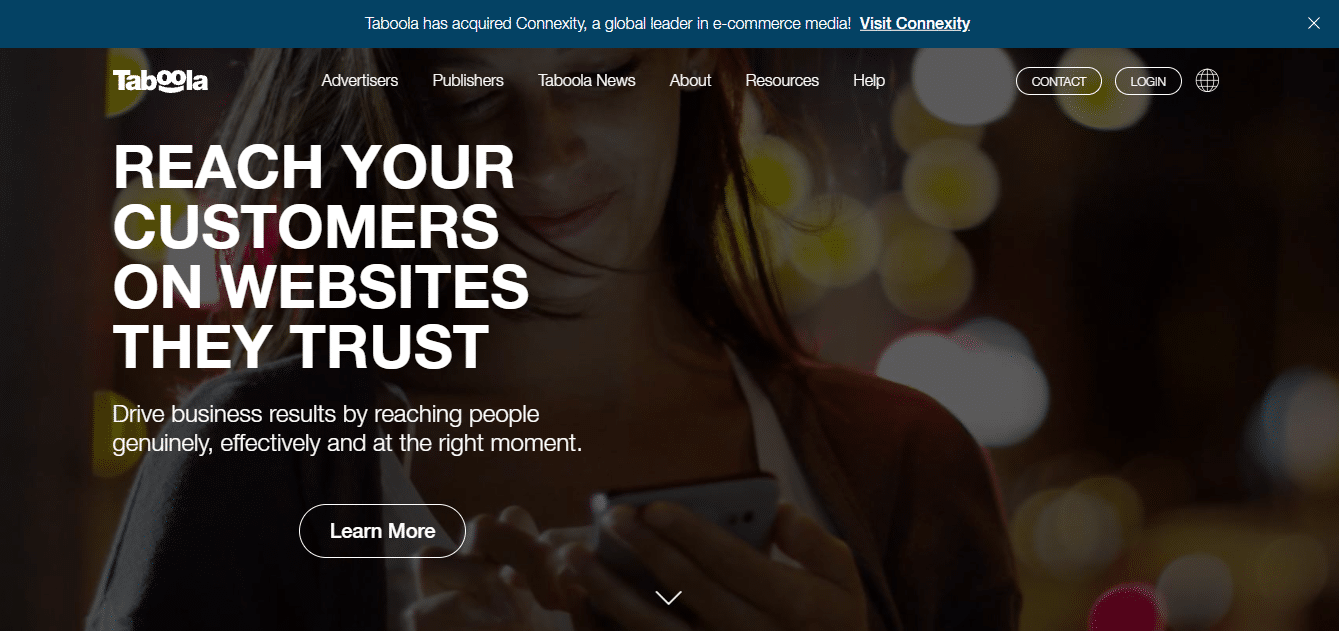
Ever visited a website and came across a “You May Like” section at the bottom with articles such as “Historians Doubt These 23 Famous People Ever Existed” or “Work from Home Jobs in the US”?
These are known as Native Ads or Sponsored Links, to be precise. Taboola uses such a system where they serve ads through content suggestions, both articles, and videos.
And since the ads blend into the site’s design, the content looks like it’s published on the site, increasing the CTRs. Some of the content suggested may appear spammy, but Taboola allows you to filter the type of content you want to show your audience.
With partners such as TMZ, The-Hollywood-Reporter, Time.com, and BBC, you can rest assured that your audience will have a wide variety of content to choose from.
However, you need at least 500,000 pageviews a month to sign up with Taboola, a fete not many bloggers have achieved. Luckily, there are some alternatives with lower traffic requirements.
These include:
- Revcontent – 50,000 page views per month
- Shareaholic – No traffic requirements
- MGID – 90,000 page views per month
- ad – No traffic requirement
- AdSense Matched Content – 10,000 page views per day
Pros:
- Very high earning potential
- It’s easy to set up
- A vast ad inventory from top sites and advertisers
- Analytics and split testing that can help in optimizing and increased earnings
Cons:
- They only accept large sites
Minimum Payout – None
Traffic Requirements – 500,000 page views per month
Payment Model – CPA, CPC, CTR, CPV
13. BlogHer

My list of the best ad networks for bloggers wouldn't be complete without mentioning BlogHer, a CPM ad network designed for sites owned by women or intended for a female audience.
They use a 50/50 revenue sharing system, with a chance to adjust the ratio to the publisher's favor if they have more than 1 million page views per month.
However, there’s no traffic requirement to join this network. As long as your site is at least 90 days old, you can apply and get approved.
They also require you to post frequently (at least once or twice a week), place the ads at the header, and don't post the ads on sponsored posts. Better yet, besides ad placements, you can also earn from reviewing products, featured posts, or participate in sweepstakes.
And if you don’t get approved, you can still join their content-syndication program and still earn.
Pros:
- No minimum traffic requirement
- Targeted ads for women, ensuring a higher CTR
- You get access to learning materials and resources
Cons:
- You can only place the ads at the top of the page
Minimum Payout – $25
Traffic Requirements – None
Payment Model – CPM
How To Choose an Advertising Network
Now that you know how ad networks work and the various types, here are some factors to consider when choosing one.
Ad Quality and Relevance
Don’t sign up for any blog advertising network you come across. Ensure they serve high-quality ads and ads that you know will be helpful and relevant to your audience.
While accepting all ads may increase your income, it may affect your overall user experience, leading to a loss of traffic and a drop in revenue in the long run.
How Large Is The Network?
It's best to always go for large networks. That way, you will have a wide variety of ads to choose from and a higher chance of finding ads relevant to your website's content.
The more relevant ads you have, the higher the CTR will be. Besides, more ads mean high competition, leading to high bids, like in auctions, leading to more ad revenue for you.
The Ad Formats Available
People respond to different types of ad formats differently.
So, if you already know the ad format your audience loves, you can select an ad network offering that format. But if you’re not sure, go for ad networks with several ad formats. That way, you can split-test and select the one that works best.
Payment Model
There are different payment models. So, it's best to analyze each and pick one that aligns with your business goals.
Below are some of the most common and what they mean:
- CPC (Cost per click) – You get paid every time a user clicks the ad. It’s best for engaged audiences
- CPM (Cost Per Mille or cost per 1000 impressions) – With this model, you get paid every time a user sees the ads – if a network’s CPM is $15, you earn $15 for every 1000 views
- CPA (Cost Per Acquisition or Action) – Here, you get paid for the action the user takes – this could be signing up or buying a product
- CPV – Cost per view, especially in video ads
- Fixed-Rate – This model isn’t as popular as it once was – it involves the blogger and ad network agreeing on a fixed rate, which isn’t affected by season, audience behavior, or general ad performance
You should also check how often they pay, their payment threshold, and how easy it is for you to meet that threshold as the best ad networks may require more than others.
Control
You need to check the level of control you get in the ads that run on your website.
You need to at least have a say in the ads they show ad placements and the ability to turn off ads for some pages. For example, if you are also presenting affiliate offers, you might have one or two stand-out articles that make you a lot of money through commissions. It might make sense to turn off ads on posts like these.
Technology
Like in every other sector, the world of ad networks is fast changing. Some technologies allow you to customize ads, detect ad block systems, filter ads, real-time bidding, real-time reporting, analytics, and many more.
For example, Ezoic just released Ezoic Leap which helps with site speed and can still serve ads to those with ad blockers.
The more up-to-date a network is the more chances of earning you'll have. However, make sure the technology behind the network is compatible with your host. Some networks have caused low page speeds, 520, and other error codes after integration.
Best Ad Networks For Bloggers In Closing
And there you have it. That wraps up this guide on the best ad networks for bloggers.
As long as you’re doing something right in your blogging career, you should get approved by at least one of these multiple ad networks and start earning from your hard work.
Ezoic or Google Adsense is where most people start, but there's no harm in trying out the lesser-known ad networks to find out how they earn.
Here's how much a site getting 10,000 visitors a day can earn if you'd like to set yourself a goal like that!
Want to learn step-by-step how I built my Niche Site Empire up to a full-time income?
Yes! I Love to Learn
Learn How I Built My Niche Site Empire to a Full-time Income
- How to Pick the Right Keywords at the START, and avoid the losers
- How to Scale and Outsource 90% of the Work, Allowing Your Empire to GROW Without You
- How to Build a Site That Gets REAL TRAFFIC FROM GOOGLE (every. single. day.)
- Subscribe to the Niche Pursuits Newsletter delivered with value 3X per week
My top recommendations










